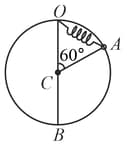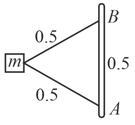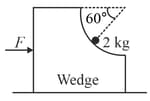B M Sharma Solutions for Chapter: Circular Motion, Exercise 56: Exercises
B M Sharma Physics Solutions for Exercise - B M Sharma Solutions for Chapter: Circular Motion, Exercise 56: Exercises
Attempt the practice questions on Chapter 9: Circular Motion, Exercise 56: Exercises with hints and solutions to strengthen your understanding. PHYSICS For Joint Entrance Examination JEE (Advanced) Mechanics I solutions are prepared by Experienced Embibe Experts.
Questions from B M Sharma Solutions for Chapter: Circular Motion, Exercise 56: Exercises with Hints & Solutions
A particle of mass is free to slide on a smooth ring of radius fixed in a vertical plane. The particle is attached to one end of a spring whose other end is fixed to the top point of the ring. Initially, the particle is at rest at a point of the ring such that being the centre of the ring. The natural length of the spring is also equal to . After the particle is released and slides down the ring, the contact force between the particle and the ring becomes zero when it reaches the lowest position . The force constant is given as 
Find the value of
Two strings of lengths, each are connected to a block of mass, at one end and their ends are attached to the point and apart on a vertical pole which rotates with a constant angular velocity, . Find the ratio of tension in the upper string and the lower string . [Use, .]

A wedge is placed on a smooth horizontal surface. It contains a circular quadrant of radius as shown. An insect crawls on the circular part with a constant speed . A force is applied on the wedge so that it does not move. Find the value of in newton when radial line of position of insect makes an angle of with horizontal.

A force of constant magnitude, acts on a particle moving in a plane such that it is perpendicular to the velocity of the body and the force is always directed towards a fixed point. Then, the angle (in radian) turned by the velocity vector of the particle as it covers a distance, is (take the mass of the particle as, ),
A toy car is moving anticlockwise on a closed track whose curved portions are semicircles of radius . The adjacent graph describes the variation of speed of the car with distance moved by it (starting from point ). Find the time required for the car to complete one lap in second, (take )

Small parts each of mass on a conveyer belt moving with constant velocity are allowed to drop into a bin. Radius of circular portion is . The static coefficient of friction between the parts and belt is . If the parts start sliding on the belt at the angle . Find the velocity (in ) of conveyer belt.






One end of a massless spring of spring constant and natural length is fixed and the other end is connected to a particle of mass lying on a frictionless horizontal table. The spring remains horizontal. If the mass is made to rotate at an angular velocity of , find the elongation of the spring (in ).
A ball is given a velocity of as shown. If the ratio of centripetal acceleration to tangential acceleration is at the point where the ball leaves circular path then write the value of . [Neglect the size of ball]

